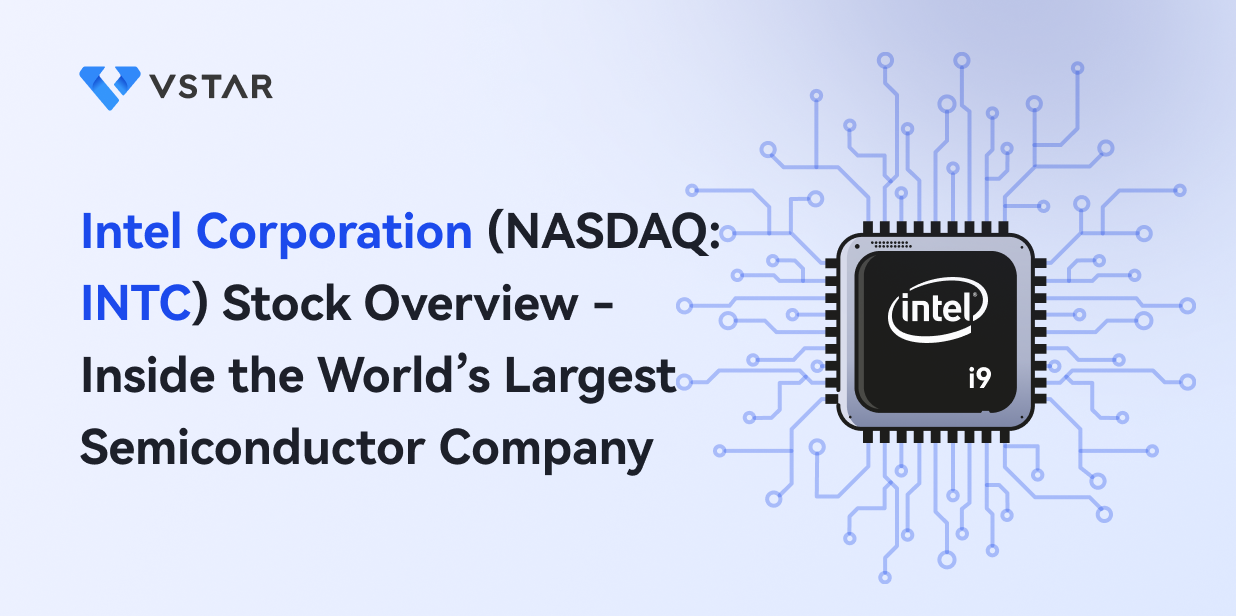As one of the most valuable companies in the world, Intel Corporation is the world’s largest semiconductor company holding nearly 15% of the global semiconductor market share. Since it has had an almost monopolistic hold on the industry for years, Intel stock has reflected that growth and is now an indicator of the challenges the company is currently going through.
The company is experiencing a slowdown and short-term headaches that don’t seem to be going away soon. But can the company turn its fortunes around and become a winner again? Here’s what you need to know.
Intel Corporation’s Background
Two Silicon Valley innovators Robert Noyce and Gordon Moore founded Intel in 1968 and were able to start commercially making products available in 1971. As it grew, Intel moved its operations from Mountain View California to San Francisco California. The brand is known for its high-quality technology and software. Its processors are used in major laptop brands.
The company is famous for introducing the first single-chip microprocessor, the first 8-bit microprocessor, and the first type of microcontroller. The current CEO of Intel is Patrick Gelsinger and Intel’s products are continuing to change personal computing in many ways and advance the development of autonomous driving.
Business Model and Products
Intel supplies graphics chips, microprocessors, motherboard chipsets, integrated circuits, and other computing units to manufacturers such as Dell or HP. The chip maker has a long history of producing a wide range of resources for different technological needs but makes most of its revenue from selling semiconductor chips. The company stays among the Fortune 500 companies in the United States by revamping its product designs and technology to maintain its innovative edge against competitors.
Intel makes money by selling semiconductor chips and other computing components to a variety of customers like data center operators, PC makers, government agencies such as the US Department of Defense, EV companies, individual businesses, and more. The company is also making significant improvements in its semiconductor business by building manufacturing facilities to increase its production abilities and market share which currently stands at 9.7%.
Main products and services
Intel is best known for supplying microprocessors to some of the world’s best computer systems manufacturers like HP, Dell, Acer, and Lenovo. Intel's second-largest product based on revenue is semiconductor chips used in most electronic devices. In addition, Intel generates revenue from selling graphics chips, motherboard chipsets, network interface controllers, and embedded processors for various computing and communications needs.
Intel’s Financials and Valuation Metrics
Intel’s potential for growth remains present but the short-term headwinds have steadily decreased the company’s revenue and other key financials. Intel’s net margin has dropped by 116% year-on-year and its operating income has also decreased by 117% year-on-year. The chip’s maker P/S ratio is at an all-time low of 1.69x along with a 2023 decline in sales.
However, Intel still has a remarkable balance sheet. The company has 26.4% of its market cap or about $28.34 billion in cash or short-term investments. Intel is still the majority owner of Mobileye by 94% meaning that $31 billion out of $33 billion of Mobileye’s market cap is in Intel’s hands which puts the company in a good position.
How does Intel Compare to its Peers?
Along with Samsung and TSMC Intel is expected to make major headway in the semiconductor industry and still holds the major share in the PC and server processor markets. However, it continues to receive a weak valuation from analysts.
Despite the tough economy, these companies including AMD appear to be faring better than Intel. AMD’s guidance for 2023 puts it at $5.3 billion in sales by Q1 2023 and a 10% YoY decrease in sales but this would be an improvement from Intel’s 40% YOY decline in sales. Intel’s forward P/E ratio of 66.23 compares favorably to Samsung’s forward P/E ratio of 27.86. INTC also has a trailing 12-month P/E ratio of 16.4 and remains around its historical average of 15.
Due to inadequate performance over the last 5 years and strong competition eating up its market share combined with decreasing revenue and profits, Intel is currently undervalued. Companies like AMD and Nvidia are currently outshining it unless the company can effectively manage the short-term obstacles.
Intel Stock Performance
Trading Information
Primary Exchange and Ticker: NASDAQ: INTC
Country & Currency: USA (USD)
Trading Hours: Pre-market hours (4:00-9:30 am ET) After Hours Market (4:00 - 8:00 pm ET)
IPO: Intel went public in 1971 at $23.50 per share
Stock Splits: Intel has done a total of 8 stock splits with the last one being in 2000.
Intel Dividend: Intel pays dividends quarterly to investors. The last dividend was paid in April 2023 at $0.13 per share
Intel stock dividend yield: 1.65% annually
Latest developments investors/traders should know
Intel Foundry Collaboration
Intel Foundry is collaborating with Arm to enable chip designers to create low-power system-on-chips. The collaboration will focus on building mobile SoC designs first before expanding to other segments like data centres, automotive, government applications, aerospace, and the Internet of Things (IoT). Intel’s new partnership is starting to give it some traction and could influence Intel's stock price increase.
Shocking Loss
Intel earnings for Q4 2022 showed horrible declines in the company’s sales, gross margin, and profits. The overall earnings report for 2022 was not good and it doesn’t help that the company didn't give any guidance for 2023 because of economic uncertainty.
Investment in Vietnam chip plant
Intel is planning to increase its $1.5 billion investment in Vietnam to expand its chip testing and packaging capabilities. This will also reduce the company’s reliance on Taiwan and China because of the increasing political risks and trading tensions.
Overview of Intel stock performance
Intel stock lost nearly half of its value in 2022 and is currently down 60% from its all-time highs. Although INTC stock increased by 14% at the start of the year mostly due to a rally for chip equities, the company’s dismal quarterly and full-year earning reports for 2022 had investors running for the hills. So, investor sentiment has been anything but good regarding Intel so far.
Intel’s struggles which include rising competition from AMD and Nvidia, and weakening demand for electronic goods might not be going away anytime soon. The company has avoided giving full-year guidance for 2023 and adjusted net loss for the coming quarter to 15 cents per share. Now trading at $30.21, Intel has reached almost a decade low and the company holds close to 26% of its market cap in short-term investments and cash.
2023 is shaping up to be another tough year for Intel and the company is gradually losing its position as the dominant chip player. But most companies are going through major challenges, especially during the post-pandemic slump and fear of inflation. So, Intel’s short-term challenges are not entirely unexpected. However, keep in mind that Intel’s road to recovery will be difficult to predict but the company isn’t done being one of the world’s most important companies.
Key drivers of Intel stock price
Upgrade in Analysts' Prediction
Intel stock forecast has received much-needed upgrades from analysts in Citigroup and Bernstein and now has a hold rating. The new upgrade was made because there is hope for Intel to meet Wall Street’s earning forecast.
A turnaround in the PC market
Another reason why analysts' Intel outlook is becoming positive is because many expect the PC market to recover soon. The PC market is Intel’s top client and the market’s recovery will be beneficial for Intel.
Analysis of Prospects for Intel Stock
Intel’s poor share price in 2022 was mostly due to its growing market loss and weak profitability. From $204 billion in 2020, Intel market cap has dropped to $129 billion signifying a rapid decrease in value. Intel's Q1 2023 report was also not encouraging as the company had to report an operating loss of $1,468 million and a diluted loss per share of $0.66.
Intel stock support levels are still strong at around $25. But considering the results Intel is delivering, the levels might not hold as investors start panic selling.
A significant recovery in INTC stock is expected to happen but perhaps not in 2023. The median Intel stock price target for 2023 is $29.50 with a high estimate of $45 if the company overcomes its short-term challenges. As it recovers, Intel stock price prediction for 2025 by analysts has the stock trading at a minimum of $78.23 and a maximum price within the region of $95.
Risks and Opportunities
These are the opportunities and risks open to Intel:
Opportunities for Intel
● Room for Growth: Intel can still expand its business in the market it is already in. Plus, the company’s diversification allows it to branch into new markets. For instance, there is still high demand for better, faster PCs and Intel can partner with more companies that make them. Also, the production of drones, AI, and edge computing are still a relatively new market that Intel has resources to tap into.
● Massive Clientele: Intel remains one of the most important companies in the world and even with the growing competition, clients will always prefer to go to someone they know will deliver the best products available in the industry. Intel is ranked 7th in brand value among tech companies and will continue to maintain its relevance from all indications. Intel stock buy or sell signals indicate that the company is a buy for long-term profits.
● Partnerships: The company’s partnership with Microsoft and Arm will continue to give it a competitive edge against its competitors. Making positive partnerships also improves investor sentiment about the company.
Risks
● Strong Competition: Intel’s almost monopolistic dominance of the market is now being challenged seriously by other chip makers like Nvidia and AMD. In the last 4 years, Intel’s CPU market share has dropped from 89.4% to 71.5% and the company may continue to lose more market share as 2023 progresses.
● Decrease in Profit: While the chip maker has been facing a drop in market share for the past decade, the company has also been experiencing significant losses. The negative financials have led to a decline in investor confidence.
● Track record of delaying new launches: The company’s competitors are continuing to innovate at a fast pace and delaying the launch of new products will only hurt their market share as other chip manufacturers create products to fill the need.
Future Outlook and Expansion
So is Intel a buy or sell? Intel is dealing with short-term headwinds that might persist throughout 2023. But Intel is a favorite of both institutional and private investors when it comes to its long-term prospects. Current Intel share price prediction for 2025 looks positive as it is expected to rise to $99 by the end of the year.
If Intel can execute its foundry business well, it will scale up the company’s designs and eventually give it a leading edge. In addition, the chip maker is taking active steps to change the architectural structure of their products and the way their chipsets are packaged by using 2D and 3D technology. Intel is still on track to deliver impressive results but the progress might take time.
How to Invest in Intel Stock
There are different ways you can invest in Intel especially when your portfolio doesn’t have enough exposure to tech stocks. The most common means is to invest in Intel stock long-term. It is a great company to hold long-term because of its growth potential. For instance, if you bought Intel stock at $1000 in 2016, it would have been worth $2,408 at the start of 2021 if you also reinvested the dividends.
Another method is options investing. Unlike long-term investing, you do not need to hold Intel stock options for long and it gives you a chance to take advantage of the current level of volatility with the option of purchasing the underlying stock after. On the other hand, investing in Intel stock CFD comes with its fair share of risks because of the short-term market volatility but it is a great investment method, especially for beginners who do not know much about the stock market and might not be willing to wait for too long for profits. It is also an effective way to take advantage of rapid price changes and any short-term news that could positively impact the stock. Before you start trading CFDs, make sure to find a broker like VSTAR that offers Intel stock CFDs as one of their products and has the tools necessary for trading.
Why Trade Intel Stock CFD with VSTAR
Trade Intel stock CFD under excellent trading conditions using VSTAR’s deep liquidity, super tight spreads, and fast order execution. You can start exploring the market for as low as $50 and hedge your trades against losses by using VSTAR’s risk management tools and balance protection system.
See any trading opportunities? Sign up and start trading in seconds!
Conclusion
Intel has not been having the easiest time so far but expects a big turnaround in 2024. Demand for PCs is predicted to increase and the stock is relatively undervalued since there is still a lot of room for the company to grow. If you want to invest, make sure to break your total capital into sizable bits to protect against risk. Also, it is a good idea to diversify your portfolio as much as possible to reduce losses.




